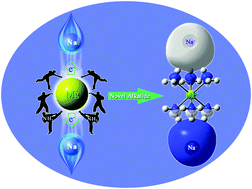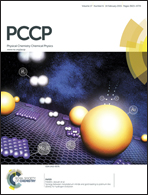A theoretical study on novel alkaline earth-based excess electron compounds: unique alkalides with considerable nonlinear optical responses†
Abstract
On the basis of stable alkaline earth metal ammines, a series of M(NH3)6NaCl and M(NH3)6Na2 (M = Mg and Ca) excess electron compounds were theoretically constructed and studied by using the density functional theory. The electride or alkalide characteristics of these compounds are verified by their electronic structures, HOMOs, and small VIE values. It is worth noting that the M(NH3)6Na2 alkalides have novel electronic structures that contain double alkali metal anions. As expected, all the noncentrosymmetric M(NH3)6NaCl and M(NH3)6Na2 compounds possess considerable first hyperpolarizabilities (β0) up to 123 050 au, which can be attributed to low excitation energies (ΔEs) and large oscillator strength (f0) of their crucial excited states. In addition, results reveal that the Ca(NH3)6-based species with lower ΔEs and larger transition moments (Δμ) show larger β0 values compared with the corresponding Mg(NH3)6-based ones with similar geometries. This study may be significant in terms of designing excess electron compounds of new-type, especially alkalides with multiple alkali metal anions.


 Please wait while we load your content...
Please wait while we load your content...